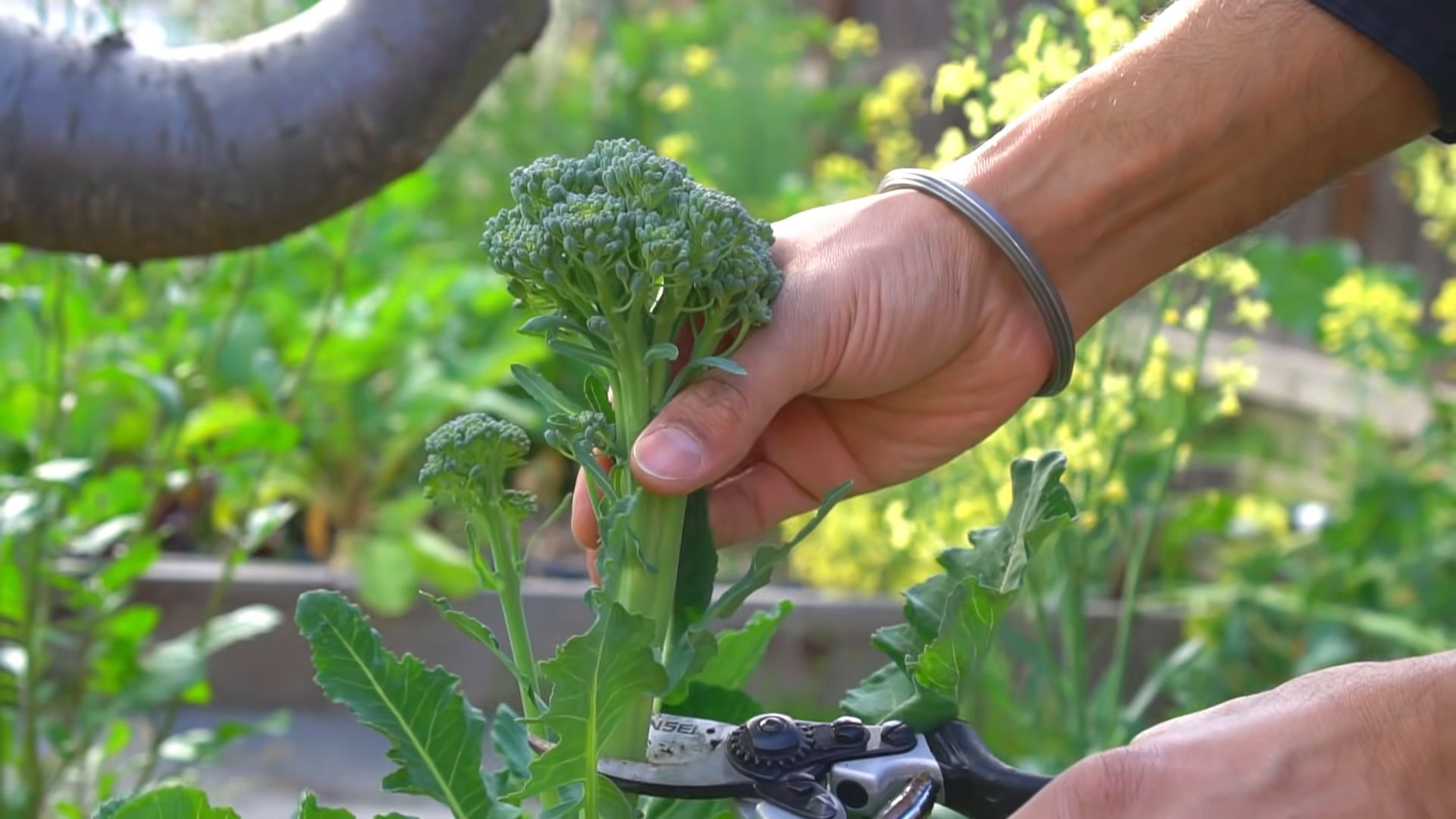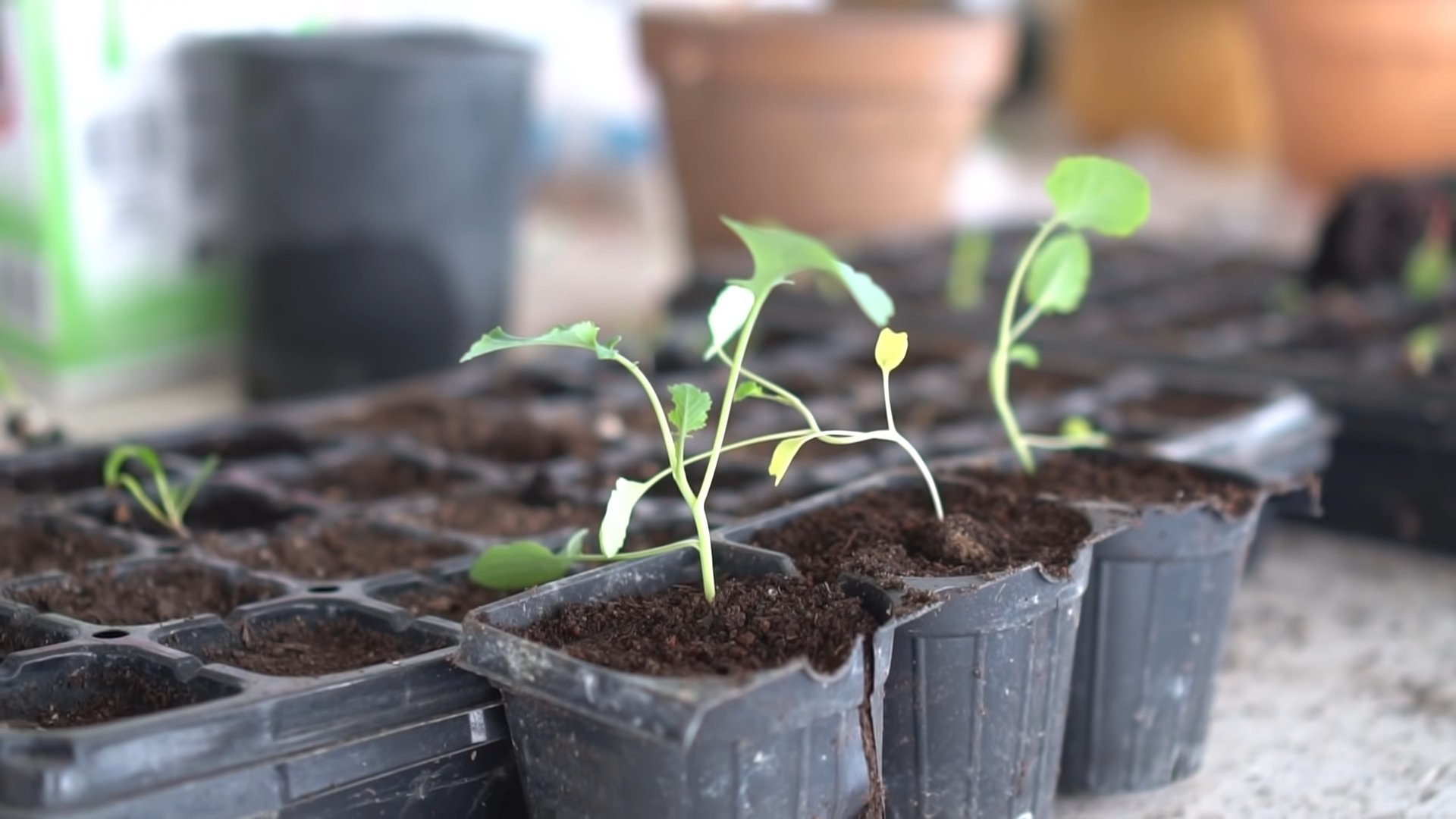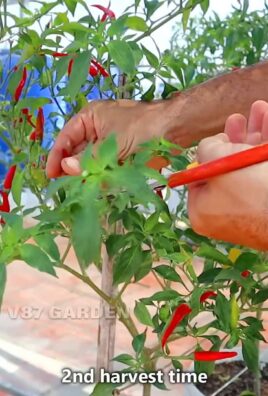Grow Broccoli at Home – sounds intimidating, right? But trust me, it’s easier than you think! Forget those pricey supermarket florets; imagine stepping into your backyard and harvesting your own crisp, delicious broccoli. This isn’t just about saving money; it’s about connecting with nature and enjoying the unparalleled flavor of homegrown goodness.
Broccoli, a member of the Brassica family, has a rich history dating back to ancient Rome. The Romans highly valued it for its nutritional benefits and unique taste. Today, this superfood remains a staple in diets worldwide, packed with vitamins, minerals, and antioxidants. But why settle for store-bought when you can cultivate your own organic supply?
In today’s world, where we’re increasingly conscious of what we consume, knowing where our food comes from is more important than ever. Growing your own broccoli allows you to control the entire process, from seed to table, ensuring it’s free from harmful pesticides and chemicals. Plus, there’s something incredibly satisfying about nurturing a plant from a tiny seed to a bountiful harvest. I’m going to share some simple yet effective DIY tricks and hacks that will empower you to grow broccoli at home successfully, even if you have limited space or gardening experience. Let’s get our hands dirty and unlock the secrets to a thriving broccoli patch!

Growing Broccoli at Home: A Beginner’s Guide
Hey there, fellow gardening enthusiasts! Ever thought about growing your own broccoli? It’s easier than you might think, and nothing beats the taste of freshly harvested, homegrown broccoli. I’m going to walk you through the whole process, from seed to harvest, so you can enjoy delicious broccoli straight from your backyard.
Choosing Your Broccoli Variety
First things first, let’s talk broccoli varieties. There are tons to choose from, each with its own unique characteristics. Here are a few popular options:
* Calabrese: This is your classic, large-headed broccoli. It’s reliable and produces a good yield.
* Waltham 29: A cold-hardy variety, perfect for areas with shorter growing seasons.
* DiCicco: This one produces smaller main heads but offers plenty of side shoots, giving you a longer harvest.
* Romanesco: If you’re feeling adventurous, try Romanesco! It has a stunning, fractal-like head and a slightly nutty flavor.
Consider your climate and growing season when making your choice. Check the seed packet for specific recommendations for your region.
Starting Your Broccoli Seeds
You have two options here: starting seeds indoors or direct sowing. I usually prefer starting indoors because it gives the seedlings a head start and protects them from pests and harsh weather.
Starting Seeds Indoors
1. Gather Your Supplies: You’ll need seed starting trays or small pots, seed starting mix (not regular potting soil!), broccoli seeds, a spray bottle, and a grow light (optional, but highly recommended).
2. Prepare the Seed Starting Mix: Moisten the seed starting mix with water until it’s damp but not soggy.
3. Sow the Seeds: Fill the trays or pots with the moistened mix. Make a small indentation (about 1/4 inch deep) in each cell or pot. Place 2-3 broccoli seeds in each indentation.
4. Cover the Seeds: Gently cover the seeds with more seed starting mix.
5. Water Gently: Use a spray bottle to mist the surface of the soil. Avoid overwatering, which can lead to damping off (a fungal disease that kills seedlings).
6. Provide Light and Warmth: Place the trays or pots in a warm location (around 70-75°F) and under a grow light. If you don’t have a grow light, a sunny windowsill will work, but be sure to rotate the trays regularly to prevent the seedlings from leaning towards the light.
7. Keep the Soil Moist: Check the soil daily and mist with water as needed to keep it consistently moist.
8. Thin the Seedlings: Once the seedlings have their first true leaves (the second set of leaves), thin them to one seedling per cell or pot. Snip off the weaker seedlings at the soil line with scissors. Don’t pull them out, as this can disturb the roots of the remaining seedling.
Direct Sowing
If you live in a region with a long growing season, you can direct sow broccoli seeds directly into the garden.
1. Prepare the Soil: Choose a sunny spot with well-drained soil. Amend the soil with compost or other organic matter to improve its fertility and drainage.
2. Sow the Seeds: Sow the seeds about 1/2 inch deep and 2-3 inches apart.
3. Water Gently: Water the soil gently after sowing.
4. Thin the Seedlings: Once the seedlings emerge and have a few true leaves, thin them to 18-24 inches apart.
Transplanting Your Broccoli Seedlings
Whether you started your seeds indoors or direct sowed, you’ll eventually need to transplant your broccoli seedlings to their final location in the garden.
1. Harden Off the Seedlings: If you started your seeds indoors, you’ll need to harden them off before transplanting them. This means gradually exposing them to outdoor conditions over a period of 7-10 days. Start by placing the seedlings outdoors in a sheltered location for a few hours each day, gradually increasing the amount of time they spend outdoors.
2. Prepare the Garden Bed: Choose a sunny spot with well-drained soil. Broccoli needs at least 6 hours of sunlight per day. Amend the soil with compost or other organic matter.
3. Dig Holes: Dig holes that are slightly larger than the root balls of the seedlings. Space the holes 18-24 inches apart.
4. Transplant the Seedlings: Gently remove the seedlings from their trays or pots. Loosen the roots slightly and place the seedlings in the holes.
5. Fill the Holes: Fill the holes with soil and gently firm the soil around the seedlings.
6. Water Thoroughly: Water the seedlings thoroughly after transplanting.
Caring for Your Broccoli Plants
Now that your broccoli plants are in the ground, it’s time to give them the care they need to thrive.
* Watering: Broccoli needs consistent moisture, especially during head formation. Water deeply whenever the top inch of soil feels dry. Avoid overhead watering, which can promote fungal diseases. Soaker hoses or drip irrigation are ideal.
* Fertilizing: Broccoli is a heavy feeder, so it needs regular fertilization. Apply a balanced fertilizer (like 10-10-10) every 2-3 weeks. You can also side-dress with compost or other organic matter.
* Weeding: Keep the garden bed free of weeds, which can compete with the broccoli plants for nutrients and water. Mulching can help suppress weeds and retain moisture.
* Pest Control: Broccoli is susceptible to several pests, including cabbage worms, aphids, and flea beetles. Inspect your plants regularly for signs of infestation.
* Cabbage Worms: These green caterpillars can quickly devour broccoli leaves. Handpick them off the plants or use Bacillus thuringiensis (Bt), a natural insecticide.
* Aphids: These tiny insects suck the sap from plants, causing them to weaken and distort. Spray them off with a strong stream of water or use insecticidal soap.
* Flea Beetles: These small, jumping beetles can create tiny holes in broccoli leaves. Cover the plants with row covers to prevent them from reaching the plants.
* Disease Control: Broccoli can also be affected by several diseases, including clubroot and black rot.
* Clubroot: This soilborne disease causes the roots to swell and become distorted. Prevent clubroot by improving soil drainage and adding lime to raise the soil pH.
* Black Rot: This bacterial disease causes yellow spots on the leaves that eventually turn black. Prevent black rot by using disease-free seeds and avoiding overhead watering.
Harvesting Your Broccoli
The moment you’ve been waiting for! It’s time to harvest your homegrown broccoli.
1. Timing is Key: Harvest broccoli when the head is firm and the florets are tightly closed. If the florets start to open and turn yellow, it’s past its prime.
2. Cut the Head: Use a sharp knife to cut the main head from the plant, leaving a few inches of stem.
3. Encourage Side Shoots: After harvesting the main head, the plant will produce side shoots. These smaller heads will continue to develop, giving you a longer harvest.
4. Store Properly: Store broccoli in the refrigerator for up to a week. To keep it fresh, wrap it loosely in a damp paper towel and place it in a plastic bag.
Troubleshooting
Even with the best care, you might encounter some problems while growing broccoli. Here are a few common issues and how to address them:
* Small Heads: Small heads can be caused by insufficient sunlight, poor soil fertility, or lack of water. Make sure your broccoli plants are getting at least 6 hours of sunlight per day, fertilize regularly, and water deeply whenever the top inch of soil feels dry.
* Yellowing Leaves: Yellowing leaves can be a sign of nutrient deficiency, disease, or pest infestation. Check your plants for pests and diseases and fertilize if necessary.
* Bolting: Bolting (premature flowering) can be caused by hot weather or stress. Choose heat-tolerant varieties and provide shade during the hottest part of the day.
Enjoying Your Harvest
Now that you’ve harvested your delicious homegrown broccoli, it’s time to enjoy it! Broccoli can be eaten raw, steamed, roasted, stir-fried, or added to soups and stews. Here are a few of my favorite broccoli recipes:
* Roasted Broccoli with Garlic and Parmesan: Toss broccoli florets with olive oil, garlic, and Parmesan cheese, then roast until tender and slightly browned.
* Broccoli and Cheese Soup: A classic comfort food made with broccoli, cheese, and cream.
* Broccoli Stir-Fry: Stir-fry broccoli florets with your favorite vegetables and sauce.

Conclusion
So, there you have it! Growing broccoli at home isn’t just a gardening project; it’s an investment in your health, your wallet, and your connection to nature. We’ve walked you through the essential steps, from selecting the right seeds to harvesting your own vibrant, green florets. But why is this DIY trick a must-try?
Firstly, the taste difference is undeniable. Store-bought broccoli, often shipped long distances, simply can’t compare to the fresh, crisp flavor of homegrown broccoli. Imagine the satisfaction of serving a side dish knowing you nurtured it from seed to plate. Secondly, you have complete control over what goes into your broccoli. No more worrying about pesticides or herbicides – you can grow organically and ensure your family is eating the healthiest possible produce. Thirdly, it’s incredibly rewarding! Watching those tiny seedlings transform into mature plants, ready to be harvested, is a truly fulfilling experience.
Beyond the basic method, there are plenty of ways to personalize your broccoli-growing journey. Consider experimenting with different varieties. ‘Waltham 29’ is a classic choice, known for its reliability, while ‘DiCicco’ offers smaller, more frequent harvests. For those with limited space, try growing broccoli in containers. Just ensure you choose a large enough pot (at least 5 gallons) and provide adequate drainage. You can even try succession planting, sowing new seeds every few weeks, to enjoy a continuous supply of broccoli throughout the growing season. Companion planting is another great way to enhance your broccoli’s growth. Marigolds can deter pests, while herbs like dill and rosemary can attract beneficial insects.
Growing broccoli at home is more than just a trend; it’s a sustainable and enriching practice. It’s a way to connect with the earth, nourish your body, and enjoy the unparalleled taste of fresh, homegrown vegetables. Don’t be intimidated by the process – with a little planning and effort, you can successfully cultivate your own broccoli crop.
We wholeheartedly encourage you to give this DIY trick a try. Start small, learn as you go, and don’t be afraid to experiment. The rewards are well worth the effort. And most importantly, we want to hear about your experiences! Share your tips, successes, and even your challenges in the comments below. Let’s build a community of home broccoli growers and learn from each other. What variety did you choose? What challenges did you face, and how did you overcome them? Your insights could be invaluable to other aspiring gardeners. So, grab your seeds, get your hands dirty, and embark on your own broccoli-growing adventure today! Let us know how your journey of growing broccoli at home goes!
Frequently Asked Questions (FAQ)
1. What is the best time of year to plant broccoli?
The timing for planting broccoli depends on your climate. In cooler regions with long growing seasons, you can plant broccoli in both spring and fall. For a spring crop, start seeds indoors 6-8 weeks before the last expected frost. Transplant seedlings outdoors 2-3 weeks before the last frost. For a fall crop, start seeds indoors in mid-summer and transplant seedlings outdoors in late summer or early fall. In warmer climates, focus on fall and winter growing, as broccoli thrives in cooler temperatures. Avoid planting during the hottest months of the year, as high temperatures can cause bolting (premature flowering). Check your local extension office for specific planting dates in your area.
2. How much sunlight does broccoli need?
Broccoli requires at least 6 hours of direct sunlight per day to thrive. Choose a planting location that receives full sun for optimal growth and head development. If you live in a particularly hot climate, some afternoon shade can be beneficial to prevent bolting. If you are growing broccoli indoors under grow lights, ensure the lights are positioned close to the plants and provide sufficient intensity. Insufficient sunlight can result in leggy plants with small, underdeveloped heads.
3. What type of soil is best for growing broccoli?
Broccoli prefers well-drained, fertile soil with a pH between 6.0 and 7.0. Amend your soil with compost or other organic matter to improve drainage, fertility, and water retention. Broccoli is a heavy feeder, so it benefits from soil rich in nutrients, especially nitrogen. Before planting, consider conducting a soil test to determine any nutrient deficiencies and amend accordingly. Avoid planting in compacted or poorly drained soil, as this can lead to root rot and other problems.
4. How often should I water broccoli?
Broccoli needs consistent moisture, especially during head formation. Water deeply and regularly, aiming for about 1-1.5 inches of water per week. Check the soil moisture regularly and water when the top inch feels dry to the touch. Avoid overwatering, as this can lead to root rot. Mulching around your broccoli plants can help retain moisture in the soil and suppress weeds. Water early in the morning to allow the foliage to dry before nightfall, which can help prevent fungal diseases.
5. What are some common pests and diseases that affect broccoli, and how can I control them?
Broccoli is susceptible to several pests and diseases, including cabbage worms, aphids, flea beetles, clubroot, and black rot. To control cabbage worms, handpick them off the plants or use Bacillus thuringiensis (Bt), a natural insecticide. Aphids can be controlled with insecticidal soap or a strong spray of water. Flea beetles can be deterred with row covers or diatomaceous earth. To prevent clubroot, ensure good soil drainage and avoid planting broccoli in the same location year after year. Black rot can be prevented by using disease-free seeds and avoiding overhead watering. Regularly inspect your plants for signs of pests or diseases and take action promptly to prevent them from spreading.
6. How do I know when my broccoli is ready to harvest?
Broccoli is ready to harvest when the head is firm, tight, and the florets are a deep green color. The individual florets should be tightly closed and not starting to open or turn yellow. Use a sharp knife to cut the head from the plant, leaving a few inches of stem. After harvesting the main head, the plant may produce smaller side shoots that can also be harvested. Harvest broccoli in the morning when the plant is cool and crisp.
7. Can I grow broccoli in containers?
Yes, you can successfully grow broccoli in containers, but you’ll need to choose a large enough pot (at least 5 gallons) with good drainage. Use a high-quality potting mix and provide regular watering and fertilization. Container-grown broccoli may require more frequent watering than broccoli grown in the ground, as the soil in containers tends to dry out more quickly. Choose a sunny location for your container-grown broccoli and consider using a support stake if the plant becomes top-heavy.
8. How can I prevent my broccoli from bolting (premature flowering)?
Bolting in broccoli is often caused by stress, such as high temperatures, drought, or nutrient deficiencies. To prevent bolting, choose bolt-resistant varieties, plant at the appropriate time of year, provide consistent watering, and fertilize regularly. Mulching around your plants can help keep the soil cool and moist. If you live in a hot climate, consider providing some afternoon shade to protect your broccoli from the intense sun.
9. What are some good companion plants for broccoli?
Good companion plants for broccoli include marigolds, nasturtiums, dill, rosemary, thyme, onions, garlic, and chamomile. Marigolds and nasturtiums deter pests, while dill, rosemary, and thyme attract beneficial insects. Onions and garlic can help repel aphids and other pests. Chamomile is believed to improve the flavor of broccoli. Avoid planting broccoli near tomatoes, strawberries, or beans, as these plants can compete for nutrients or attract pests that also affect broccoli.
10. Can I eat the broccoli leaves?
Yes, broccoli leaves are edible and nutritious! They have a slightly bitter taste similar to kale or collard greens. You can cook them in the same way you would cook other leafy greens, such as sautéing, steaming, or adding them to soups and stews. Broccoli leaves are a good source of vitamins A and C, as well as calcium and fiber. Choose young, tender leaves for the best flavor and texture.




Leave a Comment